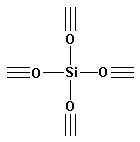Silicone Resins
Ethoxy Functional
Ethoxy functional resins cure much more slowly than silanol resins. This is because the alkoxy groups must first hydrolyze before condensation. This step requires an acid or base catalyst and moisture. Ethoxy functional resins do cure if left open to air, but the cured films are much softer than films made from silanol resins. One of the best applications for this type of product is as a concrete water repellent. This is because the moisture and alkalinity present in concrete causes only the portion of product that diffuses below the surface to cure. The ethoxy functional silicone resin offered by Genesee Polymers is listed in the table below:

MQ Type
M and Q refers to two of the four types of siloxane units found in Silicone chemistry. These are shown in the figure below:
|
M Unit |
 |
|
Q Unit
Found in silica, glass and glass resins. Will form Silicone gel by condensation of hydroxyl groups under acidic or basic conditions |
 |
MQ Resins are formed by condensing these species together in the proper ratio. These resins form hard, flexible coatings upon evaporation of the solvent. This coating is thermoplastic meaning that it softens and flows at elevated temperature. The MQ silicone resin offered by Genesee Polymers is listed in the table below:

Silanol Functional
Silanol resins are resins coated with Silanol groups (Si-OH). These reactive groups quickly condense together to form a hard coating upon evaporation of the solvent. Genesee Polymers offers two of these resins listed in the table below:

| Product | Wt. % Active | Diluent |
|---|---|---|
| GP-670 * |
25%
|
Ethyl Alcohol
Alcohols
Chlorinated Solvents
Naptha
|
|
* Besides the difference in concentrations, The main difference between GP-187 and GP-670 is that GP-670 is a higher molecular weight resin than GP-187. This allows the film formed by GP-670 to be more durable for release agent applications. |
||


